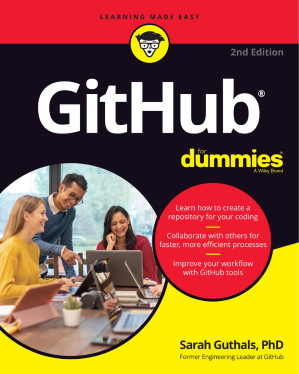Insights from GitHub For Dummies, 2nd Ed
GitHub has always been a cornerstone of my tinkering projects, whether it’s managing configurations or collaborating on open-source initiatives. When my son asked about contributing to coding projects, I thought of this book: GitHub For Dummies by Sarah Guthals. Its approachable style and step-by-step tutorials make it an excellent resource, especially for beginners navigating the complexities of version control and collaboration. For anyone curious about starting with GitHub or refining their workflows, this book promises clarity and practical advice.

Summary
Part 1: Getting Started with GitHub.com
Chapter 1: Understanding the Git in GitHub
This chapter introduces the foundations of GitHub by explaining Git, a powerful version control system. Concepts like branching and the advantages of distributed version control are presented clearly. I appreciated the emphasis on Git’s adaptability for experimentation.
Quote: “Git’s branching model encourages a culture of experimentation” (p. 16).
Chapter 2: Setting Up Your Collaborative Coding Environment
Here, the focus shifts to getting started on GitHub with a customized profile and setting up tools like GitHub Desktop. Guthals explains each step with clarity, ensuring even complete beginners feel at home.
Part 2: Starting Your First Solo Project
Chapter 3: Introducing GitHub Repositories
This chapter walks through setting up a repository, editing README files, and navigating issues. It lays the groundwork for organising and managing solo projects effectively.
Chapter 4: Setting Up a GitHub Website Repo
Creating a website repository with GitHub Pages is explained in detail. Guthals covers steps like turning a project into a hosted site, which I found particularly useful for those working on personal portfolios or documentation.
Chapter 5: Creating a Website with GitHub Pages
This chapter dives deeper into GitHub Pages, showing how to enhance websites with blogs, sections, and linked repositories. It also discusses personalising projects and making them presentable.
Part 3: Contributing to Your First Project
Chapter 6: Forking GitHub Repositories
Readers learn about forking repositories, understanding upstream changes, and contributing back to open-source projects. This chapter is particularly helpful for newcomers to collaborative coding.
Chapter 7: Writing and Committing Code
This chapter provides a guide to writing and committing changes effectively, with tips for writing clear commit messages.
Quote: “A commit message is not just documentation, but a communication tool” (p. 116).
Chapter 8: Working with Pull Requests
From opening a pull request to completing code reviews, this chapter emphasizes teamwork and communication. The breakdown of GitHub’s pull request workflow is a highlight.
Part 4: Managing and Contributing to Large Projects
Chapter 9: Exploring and Contributing to OSS
This chapter discusses exploring open-source projects, finding areas to contribute, and navigating project guidelines.
Chapter 10: Starting Your Own OSS
Readers are guided through creating open-source repositories, enforcing contributor guidelines, and managing issues effectively.
Chapter 11: Inner-Source Your Code on GitHub
The focus here is on sharing and reusing code within an organization using GitHub’s tools. It’s an inspiring chapter for teams adopting GitHub for internal collaboration.
Part 5: Making GitHub Work for You
Chapter 12: Collaborating Outside of GitHub
This chapter offers insights into integrating GitHub into workflows that involve external tools and teams.
Chapter 13: GitHub Workflow Integrations
Guthals explores automations, integrations, and customizations that enhance GitHub’s functionality for developers.
Chapter 14: Personalizing GitHub
The final chapter of this part focuses on personalizing GitHub with profile customization, themes, and saved replies.
Part 6: The GitHub Ecosystem
Chapter 15: Exploring the GitHub Marketplace
This chapter is a tour of tools, integrations, and plugins available on GitHub Marketplace to optimize workflows.
Chapter 16: GitHub and You
Guthals emphasizes the personal growth aspects of GitHub, from building portfolios to enhancing credibility in the tech community.
Chapter 17: Attending Events
The book concludes with tips for participating in events, hackathons, and GitHub-hosted community initiatives.
Part 7: The Part of Tens
Chapter 18: Ten Ways to Level Up on GitHub
This chapter lists strategies for continuous learning and mastering GitHub.
Chapter 19: Ten Ways to Improve Your Development Workflow
The focus here is on practical tips for improving productivity using GitHub tools and features.
Chapter 20: Ten Tips for Being an Effective Community Member
The final chapter emphasizes kindness, communication, and collaboration in the GitHub community.
Key Takeaways
Key Takeaway 1: Git Simplifies Collaboration
- GitHub’s branching and version control empower teams to experiment and track changes effectively.
- This principle has been transformative for teaching kids how to manage and improve their projects incrementally.
Key Takeaway 2: Contribution is Empowering
- Contributing to open-source projects fosters confidence and a sense of belonging.
Key Takeaway 3: GitHub is More Than Code
- GitHub’s tools, like Pages and Marketplace, expand its use beyond coding.
- It’s inspiring to see how diverse professionals use GitHub for design, documentation, and community building.
Personal Reflections
This book stands out as an accessible guide for both beginners and professionals. I’m particularly excited to introduce its lessons at Code Club, demonstrating how GitHub can turn small projects into collaborative learning experiences. For my son, it’s a gateway to exploring tech and building skills he can carry into the future.
Conclusion
GitHub For Dummies is a well-rounded introduction to a platform that has reshaped the world of software development. Its practical approach and beginner-friendly explanations make it a must-read for anyone looking to navigate GitHub confidently. Whether for personal growth, team projects, or inspiring the next generation of coders, this book is an invaluable resource.